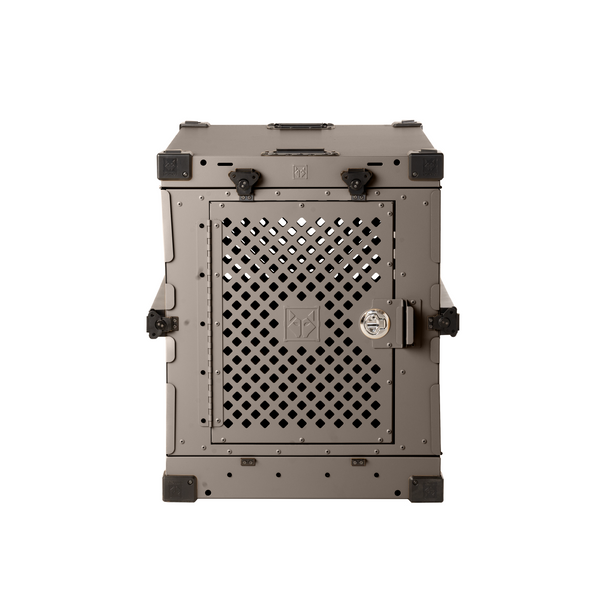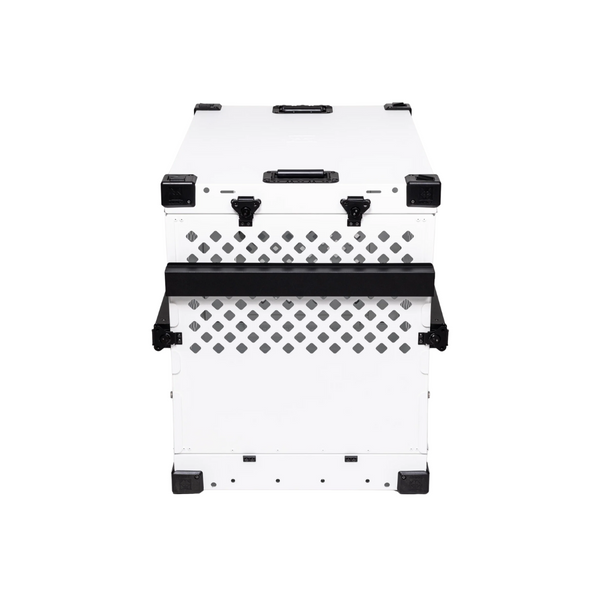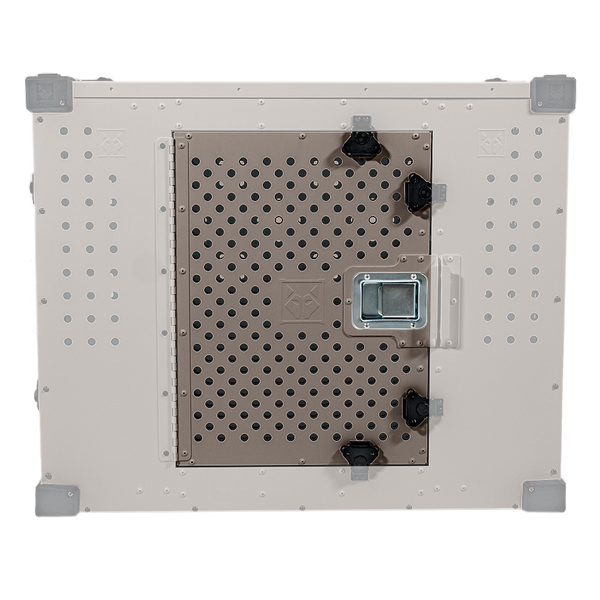Dealing with crate training regression can be frustrating when your trusted methods suddenly stop working. Why has your dog started to reject their crate, and what can you do to guide them gently back to acceptance? This no-nonsense guide cuts through the confusion, offering you straightforward answers and techniques to rekindle your dog’s positive association with their crate—and ensure comfortable and peaceful crate time for both of you.
Key Takeaways
- Crate training regression is a common challenge caused by factors like stress, fear, or changes in the environment, and recognizing the signs of regression is key to adapting training strategies.
- Creating a positive crate environment is crucial; it involves consistent training, integrating comforts like bedding and toys, and using positive reinforcement to encourage a dog’s voluntary entry and pleasant associations with the crate.
- Professional assistance from dog trainers can be sought for persistent crate training issues, and ensuring the crate fits the dog’s needs—with the right size and comfortable interior—is essential to combating regression.
What Is Crate Training Regression in Dogs?
Picture this: your once crate-happy pooch is now giving you the puppy-dog eyes whenever it’s time to “kennel up.” You’re witnessing dog crate training regression, a hiccup in your pet’s learning curve that can arise due to stress or fear. It’s a common challenge that can lead to a full-blown refusal to enter the crate. But understanding the why behind the what is crucial. Recognizing that regressions are a normal part of dog training can help you adapt your approach based on your dog’s individual needs, maintaining that special bond you share.
After all, a positive relationship with your dog and their dog crate is the foundation of good behavior, and getting to the root of crate regression can prevent a negative spiral that could impact your fur-friend’s overall well-being.
Identifying Signs of Crate Regression
So, what are the signs that your canine companion is experiencing crate training regression? It might start with a subtle reluctance to enter their crate, followed by increased anxiety behaviors like whining or pacing. These behaviors are red flags signaling that your dog might be feeling less than enthused about their den-like retreat.
Pay attention to distress behaviors, such as barking or asking to be let out at night, especially if they’re new or have resurfaced after a period of successful crate training. Even partial regression is a tell-tale sign; your dog might still be using their crate, but certain behaviors like settling down or staying quiet have slipped.
Below are a few of the most common signs of crate regression in dogs:
- Your dog no longer enters their crate on command
- Your dog struggles to get comfortable or to relax in their crate
- Your dog whines or cries in their crate for seemingly no reason
Differentiating Between Puppy and Adult Dog Regression
Understanding the difference between puppy and adult dog crate training regression is akin to recognizing that toddlers and teenagers handle stress differently. Puppies may regress due to their ever-changing developmental stages, which can throw a wrench in their learning process. On the other paw, adult dogs might backtrack in their training for a myriad of other reasons, from health issues to changes in their environment.
It’s important to remember that experiencing crate training regression is not unusual for dogs of any age, especially if they’re new to the concept of a crate.
The Psychology Behind Your Dog's Reluctance
Ever wondered why, for seemingly no reason, your furry friend has suddenly turned their nose up at their crate? Your dog's new found reluctance to go into their crate can stem from a wide variety of different reasons that range from anxiety to being uncomfortable.
Negative experiences such as overcrating can also contribute to a dog’s reluctance to use their crate. Such experiences can lead to physical and mental health issues and a negative association with the crate.
If your dog has been previously forced to soil their crate, their natural inhibitions against soiling their den can be damaged, making crate time distressing. Mistakes in the initial crate training, using the crate as punishment, or even a crate that’s not properly secured can all sow seeds of fear and reluctance. Negative associations can also stem from traumatic experiences or if the crate has been used predominantly as a form of punishment.
Recreating a positive relationship with the crate is the key to overcoming these hurdles and reversing crate training regression.
Re-establishing a Positive Crate Environment
Now, let’s talk about making the crate a positive place that your dog is excited to enter. Turning the tide on negative associations means creating an environment that feels safe and inviting.
Comfort is also paramount. Would you want to spend time in a room with hard floors and no entertainment? Probably not, and neither does your dog. That’s why incorporating an orthopedic dog crate pad, and ensuring the crate is clean and odor-free, are all part of the hospitality package you’re offering your pet.
A comfortable and protective dog crate can help to provide your dog with a safe place that they love. Often times low quality wire crates can be uncomfortable and don't feel safe for your dog which can leave them uncomfortable, stressed, and could lead to crate training regression. Here at Impact Dog Crates we strive to provide the highest quality dog crates on the market that are durable and safe but also that provide your dog with a safe place that they will love. Check out our best selling dog creates below:
The Role of Consistent Training
Consistency is the golden rule in any form of dog training. It’s the difference between a dog that’s confused by mixed messages and one that’s confident in what’s expected of them. Consistent commands and cues prevent confusion and reinforce learned behaviors, making treats and praises your best allies.
If you live in a multi-person household, it’s crucial for everyone to be on the same page when it comes to training cues and methods. This unity prevents your dog from receiving mixed signals, which can lead to regression. Keep in mind that an inconsistent routine can cause anxiety and insecurity in your pet, potentially causing them to revert to unwanted behaviors.
Incorporating Mental Exercise and Positive Reinforcement
Let’s not forget the power of mental exercise and positive reinforcement in resolving dog crate training regression. Using positive reinforcement, like praise and treats, not only builds a good relationship between your dog and their crate but also makes the training process a happy and stress-free experience. Feeding your dog in their crate is another way to create a positive link, associating it with one of their favorite activities: eating. Combine this with the right commands and rewards, and you underscore the positive aspects of crate usage.
And let’s not overlook the importance of a cozy setup for your furry companion. A comfortable crate with plush bedding and a selection of toys helps make the crate feel like a secure haven, not a place of isolation.
Professional Insights: When to Consult a Dog Trainer
Sometimes, despite your best efforts, crate training regression persists. This is when calling in a professional dog trainer becomes an invaluable step. If you’re facing ongoing behavioral issues related to crate training, or if after weeks of consistent training your dog still seems ill at ease in their crate, it’s time to seek out those professional insights.
Dog trainers can help address underlying issues, like separation anxiety or physical discomfort, that you might not be able to spot on your own. They’re also equipped to evaluate reactive behaviors and suggest alternative confinement strategies if traditional crate training isn’t working.

Tailoring the Crate to Your Dog's Needs
Selecting the right crate is not a one-size-fits-all situation. It’s about finding a space that fits your furry friend’s size, breed, and unique requirements. This means choosing a crate that allows your dog to stand, turn around, and stretch out comfortably.
For instance, the Stationary Crate offers versatility with its stackable functionality and optional side door, proving to be a snug fit for dogs of all sizes. Alternatively, the Collapsible Dog Crate is perfect for pet parents on the go, combining durability with comfort and safety for travel, complete with military-grade handles and airline approval.
Both options are constructed from sturdy aluminum, ensuring a safe and secure environment for your pet over time.
Ensuring Proper Crate Introduction
Introducing your dog to their new crate should be akin to welcoming them into a cozy den. Creating a positive association with the crate is essential, so start by making it a safe refuge where they can feel secure. Re-establish those positive associations by feeding meals in the crate and providing it with treats and toys, all on top of comfortable bedding.
Place the crate in a family area with the door open to invite curiosity and allow your dog to explore at their own pace. With a gradual and stress-free introduction, you’re setting the stage for a pleasant and anxiety-free adjustment to the crate.
The Benefits of a Comfortable Bed
When it comes to a good night’s sleep or a restful timeout, the bed inside the crate can make all the difference. The Impact Orthopedic Dog Bed is designed to maximize comfort with its water-resistant cover and memory foam that adapts to your dog’s body shape, making bed time a luxurious experience.
For an extra layer of comfort, consider adding an Impact Pad Liner to the crate, ensuring your dog feels pampered and protected.
Troubleshooting Common Crate Training Setbacks
Even the most well-behaved pups can encounter setbacks in their crate training. When your dog refuses to enter their crate, it’s important to address the issue quickly to prevent it from becoming a bigger problem. A balanced diet, alongside a steady routine of exercise and human interaction, can play a significant role in a dog’s behavior, potentially staving off issues that could lead to crate training regression.
Remember to track your pet’s progress, offer reassurance, and don’t hesitate to consult a veterinarian if the problem persists.
Addressing Health Issues Promptly
When a dog’s behavior changes, it’s crucial to consider the potential for underlying health issues. Frequent and excessive toileting, for instance, may indicate that your dog’s crate training regression has a medical basis. Consulting with a veterinarian can help you rule out any health concerns that could be contributing to the regression, ensuring you’re not mistaking a physical ailment for a behavioral one.
Maintaining a Calm and Patient Approach
As you navigate the rough waters of crate training regression, patience and understanding are your anchors. Adopting a step-by-step retraining process that respects your dog’s limits is essential to rebuilding trust and overcoming regression. It’s important to maintain a positive approach to training, using the crate to manage behaviors rather than as a punitive measure.
When severe distress signs arise, seeking professional advice is a prudent step, and you should avoid abruptly stopping crate training to prevent added stress and confusion.
Enhancing Crate Appeal Through Add-Ons and Accessories
To make your dog’s crate even more inviting, consider enhancing it with add-ons and accessories. Enrichment activities that cater to your dog’s senses, such as cozy bedding, chew toys, and even DogTV, can transform crate time into a fun and enjoyable experience.
The Stationary Side Door Add-Ons offer an alternative entry and exit point, which can be a game-changer for dogs that prefer a different approach to their crate. For an added layer of comfort, the Impact Dog Den can be attached to the Impact Orthopedic Dog Bed, elevating your dog’s crate to a whole new level of comfort.
Integrating Crates into Daily Life
Crate training success is all about integration. Feeding your dog regular meals in their crate helps them form a positive association with the space. Gradually increasing the time they spend in the crate, even while you’re at home, prepares them for longer periods alone.
If you’re training a puppy, here are some tips to help you establish a routine:
- Place the crate in your bedroom or nearby during the night to provide them with a sense of security.
- Adhere to a consistent daily routine that includes crate time, play, and walks.
- Establish a stable and secure environment for your dog.
Advanced Crate Training Techniques for Persistent Cases
For the stubborn cases of crate training regression, it might be time to employ some advanced techniques. Counter-conditioning and desensitization can be effective in altering your dog’s negative perception of the crate. Regular and frequent training sessions encourage swift learning and the retention of desired behaviors within the crate. If you’re facing a particularly tough case, you may need to go back to the initial steps of crate training to rebuild that positive association.
During the recovery from crate training regression, focus on refining your approach, taking a step back if necessary, and addressing any root issues head-on. After meals and during training, progressively increase the amount of time your dog spends in the crate, preparing them for longer stays.
Frequently Asked Questions About Dog Crate Regression
What should I do if my dog suddenly refuses to enter their crate?
If your dog suddenly refuses to enter their crate, try re-establishing a positive association with the crate using treats, toys, and comfortable bedding. Consider consulting a professional dog trainer if the issue persists.
How can I tell if my dog's crate training regression is due to a health issue?
If your dog is exhibiting frequent and excessive toileting, it's important to consult a veterinarian to rule out any medical issues causing the crate training regression.
Are there different crate training approaches for puppies compared to adult dogs?
Yes, crate training approaches may differ for puppies and adult dogs due to developmental differences and potential causes of regression. It's important to be patient and tailor training strategies to their specific needs.
Can the type of crate affect my dog's comfort and willingness to be crated?
Yes, the type of crate can definitely affect your dog's comfort and willingness to be crated. It's important to choose the right size and type for your dog's needs, with features like comfortable bedding and adequate ventilation.
What are some advanced techniques I can use if my dog continues to resist crate training?
If your dog is resisting crate training, you can use counter-conditioning and desensitization techniques to change their negative perceptions of the crate. It's also helpful to revisit the initial steps of crate training and gradually increase the time spent in the crate after meals and during training sessions. Good luck with the training!














